 Abraham Lincoln
If given the truth, the people can be depended upon to meet any national crisis...
Abraham Lincoln
If given the truth, the people can be depended upon to meet any national crisis...
 Guildford news...
for Guildford people, brought to you by Guildford reporters - Guildford's own news service
Guildford news...
for Guildford people, brought to you by Guildford reporters - Guildford's own news service
Guildford Western Australia Celebrates A Special Military Centenary
Published on: 16 Nov, 2013
Updated on: 18 Nov, 2013
Our correspondent from Guildford, Western Australia, Barbara Dundas has emailed details and pictures of its recent celebration marking the 100th anniversary of its artillery HQ.
On November 3, 2013, the historic town of Guildford Western Australia, celebrated 100 years since the artillery established its headquarters adjacent to the town.
On the November 1, 1913, the people of the township welcomed the 38th Battery as it took up its headquarters. The residents of Guildford were asked to look after these men, thereby establishing a tradition that has lasted 100 years.
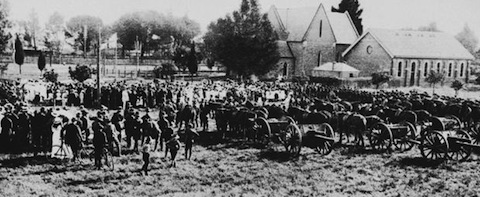
The 38th Battery of the Australian Field Artillery are welcomed at Guildford on November 1, 1913. Picture courtesy of LISWA, Battye Library, Western Mail newspaper, November 7, 1913.
Following the military traditions of England, the mother country as it was referred to then, Australia after Federation adopted the recommendations of the Kitchener Report.
Compulsory conscription was introduced in 1911 and the following year the Federal Government started acquiring land and facilities for training. In 1912, 203 acres was purchased from the Malahide Estate in South Guildford, for military purposes.
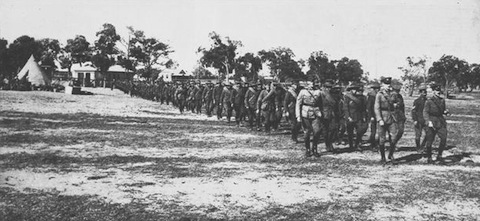
A photo from the West Australian newspaper of February 11, 1916, showing the 17th, 18th and 19th Reinforcements of the 8th Battery leaving the Guildford Depot.
In 1913, as the Mayor of Guildford welcomed the new recruit,s he spoke of Guildford becoming the ‘Aldershot’ of WA, for the 13th Field Engineers were to be based in Guildford, the 10th Light Horse, the Signallers and Remount staff.
This group of young Artillery Reservists he believed would be an efficient unit of defence and Guildford must look after them. He described them as a fine group of young men – worthy of their country, the flag and the King.
Within 12 months, most of these young men had enlisted in the Australian Imperial Forces and were on their way to Egypt, to take part in battles such as Gallipoli. The 37th and 38th Batteries were designated the 8th Field Battery under the 3rd Australian Artillery Field Brigade.
They were one of the first units to see action at Gallipoli and fired the final shot. They served with distinction and contributed to the ANZAC legend that has become a defining point in Australian history and nationhood.
After 1915 the Artillery and other units were moved to the Western Front. Men trained at camps like Hurdcott.
In 1919 the war weary and injured soldiers returned home. The churches and schools of Guildford gathered names for their honour rolls and war memorials. There are eight honour rolls in the town today.
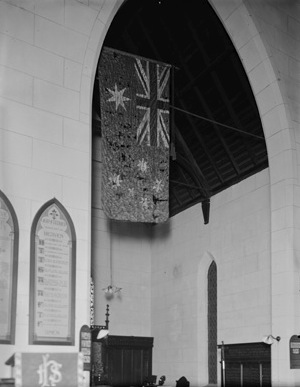
The artillery flag presented to the Garrison Church of St Matthews. Picture courtesy of LISWA, Battye Library, 101624PD.
Men of the 8th Battery considered the future of the silk ensign presented to them prior to leaving Albany, Western Australia. It had been flown at Mena Camp, on the Somme and at Ypres. It was decided it should be presented to St Matthew’s the garrison church, where it was accepted as a most sacred treasure to valued by the community in 1919.
Two years later the town received a war trophy of a howitzer gun, captured at Hamel, France. This was melted down for the war effort in 1944 and subsequently replaced with two more recent guns in 1960. These were replaced by the Royal Australian Artillery Comrades Association (RAAACA) in 1974, due to their deteriorating condition. They still stand today next to the war memorial.
In 1928 the RAAACA) organised a gunners’ march with the support of St Matthew’s, residents and Guildford municipality. This was first held on August 8, 1928, 10 years after the Australian troops played a significant role in breaking the Hindenburg Line at Villers-Brettonneux.
The day of the march was later changed to the first Sunday in November, because of the inclement winter weather. This march continues to this day and is the only regimental march held outside Anzac Day in WA. 2013 was the 85th Gunners’ Day march held.
In Stirling Square also stands the Memory Gates, unveiled in 1932 to the memory of the Artillery, Light Horse and AIF who trained at Guildford.
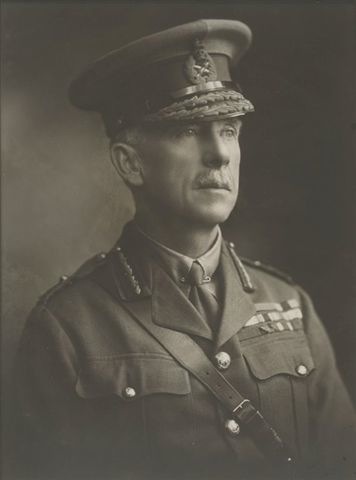
Lieut General Sir J. J. Hobbs, whom the gates honour. The new gates use both old timbers and architectural featurs from Hobbs’ original front gates of 1932. Hobbs was a noted architect, soldier and citizen in Australia. He originally came from England as a builder and later married his boss’s daughter. Picture: RAAHS WA.
Guildford’s military tradition is a significant part of its history and features are visible throughout the town. The City of Swan (the amalgamated municipality including the town of Guildford), agreed to confer on the town a gift of gates at the original church entry, to mark the centenary of Artillery establishing its headquarters in Guildford.
The gateway came from remnants of the original front gates of Lieutenant General Talbot Hobbs. He was an Australian commander of the Artillery and later Australian Forces. This gate was unveiled on November 3, 2013, as Guildford recalled its commitment made 100 years ago.
Servicemen, reservists and cadets marched into Stirling Square, led by a military band. They stopped at the gates for the unveiling, then marched through them to the war memorial where the wreath laying took place.
Brigadier G. A. Warner and Mayor C. Zannino unveiled the plaque commemorating the event. The march and service was organised by the Royal Australian Artillery Association WA.
The military, families and guests proceeded to St Matthew’s Garrison Church for a moving service. A fine luncheon was held by the City of Swan at the Guildford town hall, where a photographic display of photos from Lieut Gen Hobbs’ personal albums was displayed together with photos from the official war album.
This event marked another significant day in the town’s history. If ever any Guildfordians from UK are visiting WA, they are welcome to view our wartime monuments and our shared history.
Responses to Guildford Western Australia Celebrates A Special Military Centenary
Leave a Comment Cancel replyPlease see our comments policy. All comments are moderated and may take time to appear.
Recent Articles
- Guildford Institute’s Crowdfunding Project for Accessible Toilet in its New Community and Wellbeing Centre
- Letter: Guildford – Another Opportunity Missed?
- Letter: GBC’s Corporate Strategy – Where Is the Ambition?
- My Memories of John Mayall at a Ground-breaking Gig in Guildford Nearly Six Decades Ago
- Westborough HMO Plans ‘Losing the Heart of the Street’ Says Resident
- College Invests to Boost Surrey’s Economy and Close Digital Skills Gap
- Community Lottery Brings Big Wins for Local Charities
- GBC Housing Plan Promises ‘A Vibrant Urban Neighbourhood’ Near Town Centre
- Hospital Pillows ‘Shortage’ at the Royal Surrey
- Updated: Caravans Set Up Camp at Ash Manor School


Recent Comments
- Ian Macpherson on Updated: Main Guildford to Godalming Road Closed Until August 1
- Sara Tokunaga on GBC Housing Plan Promises ‘A Vibrant Urban Neighbourhood’ Near Town Centre
- Michael Courtnage on Daily Mail Online Reports Guildford Has Highest-paid Council Officer
- Alan Judge on GBC Housing Plan Promises ‘A Vibrant Urban Neighbourhood’ Near Town Centre
- John Perkins on GBC Housing Plan Promises ‘A Vibrant Urban Neighbourhood’ Near Town Centre
- S Collins on GBC Housing Plan Promises ‘A Vibrant Urban Neighbourhood’ Near Town Centre
Search in Site
Media Gallery
Dragon Interview: Local Artist Leaves Her Mark At One of England’s Most Historic Buildings
January 21, 2023 / No Comment / Read MoreDragon Interview: Lib Dem Planning Chair: ‘Current Policy Doesn’t Work for Local People’
January 19, 2023 / No Comment / Read MoreA3 Tunnel in Guildford ‘Necessary’ for New Homes, Says Guildford’s MP
January 10, 2023 / No Comment / Read More‘Madness’ for London Road Scheme to Go Ahead Against ‘Huge Opposition’, Says SCC Leader
January 6, 2023 / No Comment / Read MoreCouncillor’s Son Starts Campaign for More Consultation on North Street Plan
December 30, 2022 / No Comment / Read MoreCounty Council Climbs Down Over London Road Works – Further ‘Engagement’ Period Announced
December 14, 2022 / No Comment / Read MoreDragon Interview: GBC Reaction to the Government’s Expected Decision to Relax Housing Targets
December 7, 2022 / No Comment / Read MoreHow Can Our Town Centre Businesses Recover? Watch the Shop Front Debate
May 18, 2020 / No Comment / Read More



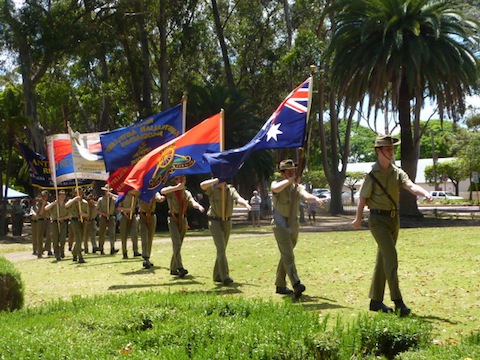
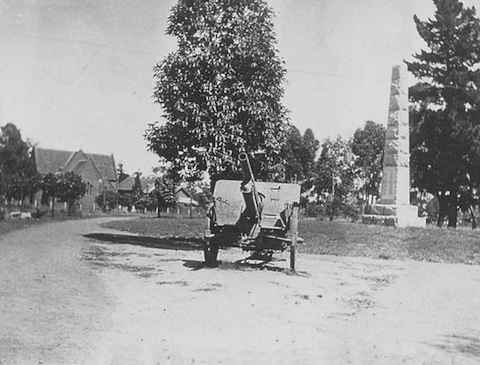

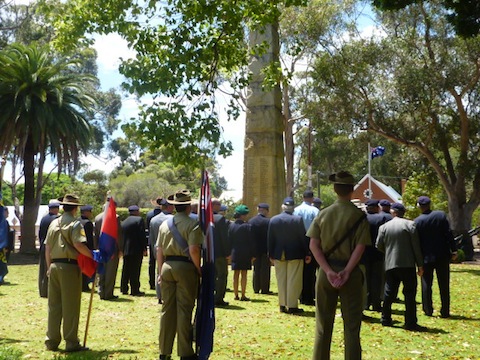






Bernard Parke
November 16, 2013 at 8:53 pm
It is surely time that we fostered this relationship with Guildford in Western Australia.
We must not forget our past history and the part that Guildford and Guilfordians played.
Kathryn Stephenson
November 20, 2013 at 11:25 am
Hello,
I am in Guildford, W.A. [Western Australia] I attended the opening of the Talbot Hobbs Gates and the memorial service afterwards.
It was a splendid day and luckily not too hot. It was an honour to attend this event. Anything to do with our ANZACS is very important here in Australia. The mere mention of ANZAC conjures up a sense of national pride and a sense of mateship. It makes one proud to be Australian.
The town of Guildford here is a wonderful place to live.
Best to everyone.
Always great to hear from our fellow Guildfordians in Western Australia.
The 2/4th battalion of our local regiment, The Queen’s Royal Regiment [now the Princess of Wales Royal Regiment] served alongside the ANZACS at Gallipoli.
Thanks for taking the time to write. It’s a little chilly here, about 5 degrees C. Some say snow is on the way.
I wonder if we will hear from any of the other Guildfords? Ed
Auriol Earle
December 2, 2013 at 6:29 pm
I imagine that Stirling Park, Western Australia, takes its name from Governor Stirling who is buried in the churchyard bordering Stoke Road, Guildford, Surrey.
He married a Guildford girl from Woodbridge House and there is much information available about him and the Guildford Institute of Western Australia in the Guildford Institute Library and Archive, Ward Street, Guildford Surrey.
In 1988 the Keep, our Guildford Institute’s magazine, carried a picture of the Guildford Institute, near Perth Western Australia. Indeed, the then Agent General of Western Australia who was visiting England for the bi-centennial celebrations visited an ambitious exhibition organised by our Institute to mark this event.
It would be particularly appropriate for Guildford, Surrey to highlight this link when it marks the centenary of the Great War next year: the pictures and information which you have published and the material available from the Institute would provide rich sources for an exhibition.
David Rose adds: Thank you Auriol for you comment. Yes you are right about Admiral Sir James Stirling. He ands his wife Ellen (nee Mangles) and Woodbridge House where they lived when they returned from Australia (where the Wickes store is now) have been featured several times previously on The Guildford Dragon News.
Barbara Dundas from Guilford WA has kindly sent me some booklets that have been published in conjunction with their recent celebrations. If anyone would like a free copy, first come first served based, I will soon be delivering them to the Stirling Centre at Stoke Church and I’ll drop a few off at the Guildford Institute.
Auriol Earle
James Higgs
May 1, 2014 at 5:22 am
I visited Guilford, Perth recently and was given a tour around by Barbara Dundas. It was a moment of great pride to see the memorial to Admiral Sir James Stirling and to realise that my great uncle helped launch something that has stood the test of time.